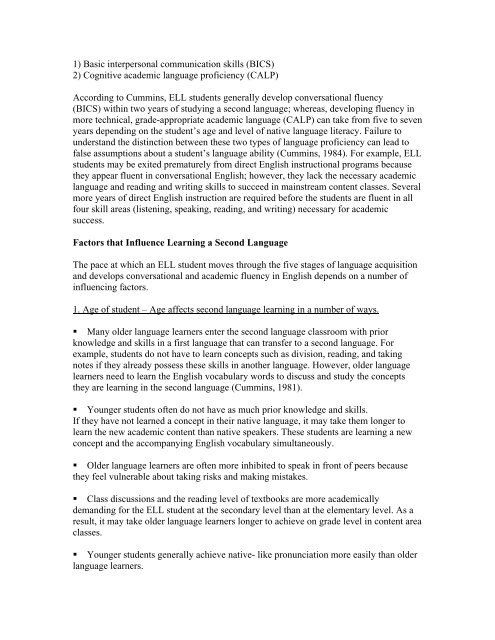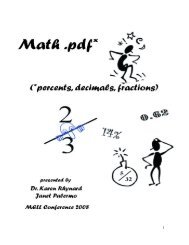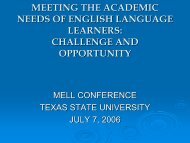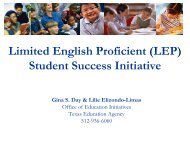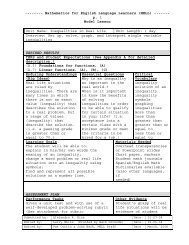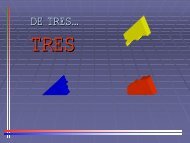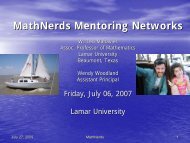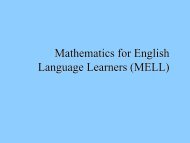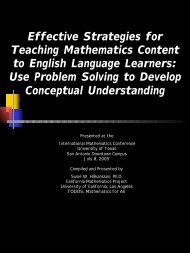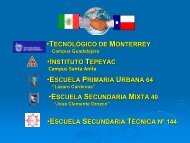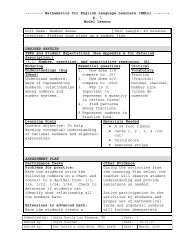Strategies for Teaching Mathematics to English Language Learners
Strategies for Teaching Mathematics to English Language Learners
Strategies for Teaching Mathematics to English Language Learners
Create successful ePaper yourself
Turn your PDF publications into a flip-book with our unique Google optimized e-Paper software.
1) Basic interpersonal communication skills (BICS)<br />
2) Cognitive academic language proficiency (CALP)<br />
According <strong>to</strong> Cummins, ELL students generally develop conversational fluency<br />
(BICS) within two years of studying a second language; whereas, developing fluency in<br />
more technical, grade-appropriate academic language (CALP) can take from five <strong>to</strong> seven<br />
years depending on the student’s age and level of native language literacy. Failure <strong>to</strong><br />
understand the distinction between these two types of language proficiency can lead <strong>to</strong><br />
false assumptions about a student’s language ability (Cummins, 1984). For example, ELL<br />
students may be exited prematurely from direct <strong>English</strong> instructional programs because<br />
they appear fluent in conversational <strong>English</strong>; however, they lack the necessary academic<br />
language and reading and writing skills <strong>to</strong> succeed in mainstream content classes. Several<br />
more years of direct <strong>English</strong> instruction are required be<strong>for</strong>e the students are fluent in all<br />
four skill areas (listening, speaking, reading, and writing) necessary <strong>for</strong> academic<br />
success.<br />
Fac<strong>to</strong>rs that Influence Learning a Second <strong>Language</strong><br />
The pace at which an ELL student moves through the five stages of language acquisition<br />
and develops conversational and academic fluency in <strong>English</strong> depends on a number of<br />
influencing fac<strong>to</strong>rs.<br />
1. Age of student – Age affects second language learning in a number of ways.<br />
• Many older language learners enter the second language classroom with prior<br />
knowledge and skills in a first language that can transfer <strong>to</strong> a second language. For<br />
example, students do not have <strong>to</strong> learn concepts such as division, reading, and taking<br />
notes if they already possess these skills in another language. However, older language<br />
learners need <strong>to</strong> learn the <strong>English</strong> vocabulary words <strong>to</strong> discuss and study the concepts<br />
they are learning in the second language (Cummins, 1981).<br />
• Younger students often do not have as much prior knowledge and skills.<br />
If they have not learned a concept in their native language, it may take them longer <strong>to</strong><br />
learn the new academic content than native speakers. These students are learning a new<br />
concept and the accompanying <strong>English</strong> vocabulary simultaneously.<br />
• Older language learners are often more inhibited <strong>to</strong> speak in front of peers because<br />
they feel vulnerable about taking risks and making mistakes.<br />
• Class discussions and the reading level of textbooks are more academically<br />
demanding <strong>for</strong> the ELL student at the secondary level than at the elementary level. As a<br />
result, it may take older language learners longer <strong>to</strong> achieve on grade level in content area<br />
classes.<br />
• Younger students generally achieve native- like pronunciation more easily than older<br />
language learners.


